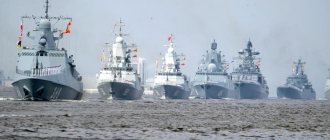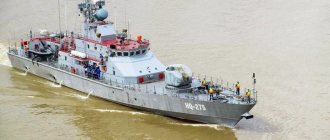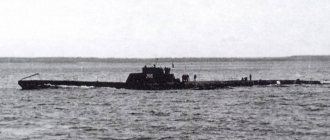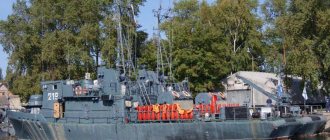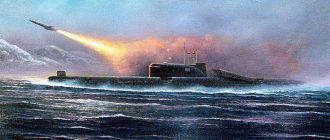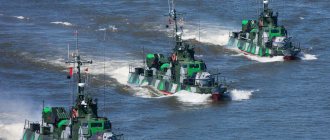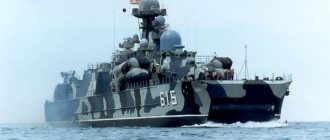The black flag, barrels of rum, eye patches - this is not about pirates. Capture, robbery and murder - that's what piracy is. It’s easy to sink to the level of a sea robber, especially when there’s war all around and there’s no one to keep order. This is what Soviet sailors had to face in the Red Sea at the turn of the 80s and 90s. The “Reconnaissance” was especially distinguished - a small ship that did not give in even to a much superior enemy.
Service at Hell's Gate
Back during the Cold War, when Ethiopia joined the socialist camp, a Soviet naval base appeared on the Dahlak archipelago (in Arabic this means “Gate of Hell”) in the Persian Gulf. However, “base” is a strong word. A pier, a dock, a workshop, fuel depots and a village where the families of Soviet sailors who served on the Red Sea lived - that’s the whole base. Service on the Red Sea - how tempting it sounds! But only for those who have never performed this very service. Ten months of the year the region experiences unbearable heat. 30 degrees in the shade (although what the hell is shade in the sea?) can be considered cool. The temperature of over-salted water remains at the same level. There is nowhere to wait for salvation; the winds blow from the deserts. Under such conditions, any scratch instantly turns into a purulent wound. Fresh water is strictly limited. Doesn't sound like a very pleasant cruise, don't you think? But Soviet sailors are no strangers; you can’t starve these people out. The Red Sea bandits experienced this the hard way. Remember the old children's acrostic poem? Every hunter wants to know... where the line is that separates man from animal. Apparently, this is where the line separating a freedom fighter from an ordinary pirate is. By the early 1990s, the long civil war in Ethiopia was coming to an end. The government of Mengistu Haile Mariam, which was supported by the USSR, was collapsing under pressure from separatists from the Eritrean People's Liberation Front (EPLF). The fighting gained momentum, Soviet ships began to be subjected to regular raids, the militants’ methods became more and more impudent and eventually slipped into banal robbery - senseless and merciless. In the spring of 1990, the EPLF finally drove the Ethiopians out of Eritrea and the latter, without thinking twice, threw the remaining ships into the port of Dahlak, essentially under the protection of the USSR. Having assessed what the real intervention of the “red military machine” in the conflict could turn out to be, the leaders of the EPLF hastened to announce that any Soviet ship spotted in the vicinity of Dahlak would be destroyed. The bitter experience of the limited contingent in Afghanistan was still too fresh in the memory to rush into trouble and restore order in a foreign war in a foreign country. But the common sense of one pole could not overcome the frenzied recklessness of the other. The separatists wanted to flex their muscles in public and were not going to deny themselves this simple pleasure. Especially when the enemy was outnumbered and, in their short-sighted opinion, could not fight back hard enough. Fortunately for the separatists, the Land of Soviets had no time for their fuss. But the Soviet sailors, who had already served in the Red Sea, still had to take up arms.
The birth of minesweepers
With the advent of a new type of weapon - sea mines - in the arsenals of the fleets of the largest maritime powers, the question arose of searching for and neutralizing them. Mines have become the main means of defending naval bases and disrupting enemy sea communications. The age-old “shield-sword” question was successfully resolved for the first time in the Russian Navy. Mine sweepers received their baptism of fire in 1904 during the Russo-Japanese War. The combat experience of Russian minesweepers was thoroughly studied in other countries, which resulted in a sharp increase in the number of minesweepers in active fleets during the interwar period.
Convoy ship
While the big guys were measuring their strength, the modest hard worker “Reconnaissance”, Captain 3rd Rank Viktor Nosenko from the Black Sea Fleet, was trying on a new role - the role of a convoy ship. In the very first mission, the “Reconnaissance” protected the entrusted tanker “Iman” from a rocket that exploded a few meters away, after which it became his job to expose the side to the shells of the separatists who had finally broken the leash. He went out on convoys twice a week, tried to move in the dark so as not to attract unnecessary attention, but this did not save him from endless shelling. Usually the matter was limited to Grad salvoes from the shore, but on May 14, 1990, everything did not go according to plan. On the night of May 13-14, the Razvedchik was supposed to protect the Far Eastern tanker International. The elderly captain of a middle-aged heavy ship listened to Nosenko’s instructions with open skepticism, after which, just in case, he graciously allowed the tiny escort (with its 61 m length and 735 tons of displacement, the “Reconnaissance” was three times smaller and 20 times lighter) to protect the slow-moving tanker. At about 3 o'clock in the morning the convoy entered the danger zone. As expected, a combat alert was announced. As soon as the "Reconnaissance" took its position, obscuring the "International", the roar of the "Grads" was heard from the banks. The test itself is not for the faint of heart, but everything turned out okay. An hour later the convoy left the shelling zone. But as soon as the alarm was replaced by combat readiness, four bright dots appeared on the radar, emerging from behind the island and rushing in pursuit. NFOE boats. Eight minutes later, the boats approached the convoy at a distance of less than a nautical mile and formed a “wolf pack”. Tracer tracks traced the darkness. The Eritrean filibusters clearly did not go on a boat trip. They were going to kill.
Modular mine action systems
Recently, the rapid development of mine countermeasures forces has resulted in the use of modular mine countermeasures systems (MAS). Equipped with these systems, warships and submarines can now independently combat mines without the need for minesweepers. The most interesting MPS is the US Navy's uninhabited underwater vehicle RMS AN/WLD-1. A semi-submersible, remotely controlled vehicle with a towed side-scan locator is capable of independently searching for mines for quite a long time at a great distance from the carrier ship. The US Navy currently has 47 such devices.
One against four
This is probably a good time to mention that the Scout was neither a cruiser nor even a patrol ship. He was a minesweeper. Cleared the passage of friendly ships from mines scattered across the Red Sea. The weapons on it include two 30-mm AK-230 stern artillery mounts, two 2M-ZM anti-aircraft guns with 25 mm caliber and a pair of rocket launchers for anti-submarine warfare. And all this “power” had to measure their strength against four Swedish-built boats, vying with each other, firing from 106-mm guns. There was no time to panic. Nosenko transmitted to the squadron: “I came under attack, entered into battle,” after which he advised the captain of the International to quickly retreat. It didn't take long to ask. Out of fright, the loaded tanker showed amazing agility, accelerating to almost 16 knots instead of the declared 9. Having given full speed, the "Reconnaissance" opened fire from everything that could fire, except bomb launchers. Even the machine gunners of the combat counteraction group, who usually remained on the sidelines, were involved. The unfortunate minesweeper was thrown from side to side, enemy shells tore the hull, but it continued to fire back. The roar and flashes filled everything around, absolute hell was happening, but to the credit of the navigators, they did not lose their composure and continued to plot the escape route. A few minutes later, one of the “Utes” fell silent: the sonar operator Igor Shvets standing behind him was wounded in the leg. Almost immediately the second machine gun fell silent. Jammed. In the sighting column open to all enemies, Petty Officer 1st Article Alexander Nevzrachny was frantically spinning around, trying to identify at least one target using the crazed trajectories of the tracers. Finally he succeeded. One aimed burst - and the lead boat of the “flock” was blown up and disappeared into the waves, after which its comrades, so brave a second ago, took off in a shameful flight. At 4:56 am it was all over. The small but proud convoy ship not only saved the tanker under its care, causing fire on itself, but also came out of the heat without losses. If you don’t count the losses as Shvets, who was wounded in the leg, and the political officer, who was hit by a teapot falling on his head. The battle with the Eritrean pirates lasted only eight minutes, but during this time the “Reconnaissance” managed to use up four and a half of the six tons of available ammunition, for which, even at the height of the battle, it managed to get hit in the cap. However, after the minesweeper returned to base, the command of the operational squadron managed to come to its senses. The Black Sea crew were greeted as heroes and were not stingy with awards - 17 crew members were awarded orders and medals. Already on the shore they learned that the Vremya program had managed to report the incident with the International. Only about “Scout” not a word was said.
Some terminology
According to their operating principle, minesweepers are divided into sea, base, raid and river. Trawls are also divided into acoustic, contact and electromagnetic. Acoustic ones are designed to detonate acoustic mines, simulating the sound of a ship passing. Contact trawls are the simplest in design and consist of a chain with knives that cut off the mine-holding cables, after which the floating charge is destroyed from the side of the minesweeper using machine guns or small-caliber artillery. Electromagnetic ones create an electric field that simulates a passing ship, and are used against magnetic mines. In the photos of minesweepers you can also see installations of depth charges, with the help of which the minesweeper can perform the functions of a submarine hunter.
Dembel chord
Less than a week had passed before our poor minesweeper again found itself in “a new mess.” On May 27, he was given the task of transporting 70 retired sailors from the port of Aden to the Yenisei ambulance ship. The route promised to be not easy, so the AK-213 artillery boat of Lieutenant Commander Nikolai Bely came out to support the “Reconnaissance”. During the transition, the convoy was captured in pincers. And again the same vile tactics, and again a raid with superior forces. Four battered but dangerous West German Jaguars came out to meet the AK and the minesweeper and demanded immediate surrender. Of course, the Soviet sailors did not even allow such thoughts, but you can’t really fight with almost peaceful passengers on board. After a short meeting, it was decided to break through. The boat somehow miraculously succeeded, although its stern was almost physically burning from the collective hatred of its pursuers. The Eritreans were not going to get off their tail, so Captain Bely decided to take a risky trick - dropping a depth charge to distract the enemy. It was impossible to predict whether it would shoot or not. But it fired! But how! One of the Jaguars fell directly into the bubble of an underwater explosion. He was thrown into the air and knocked over. Seconds - and he disappeared into the waves. The bandits took to their heels, and the demobilized people, stunned by such a farewell cruise, were safely taken to the Yenisei. True, on the way back, the AK-213 was already waiting for Eritrean women who had managed to dry their panties, but this time the boat took the fight. With targeted artillery fire, the Soviet sailors sent another Jaguar to the bottom and emerged victorious. There wasn't even a scratch left on the AK itself.
Barracuda signal
The hot days on the Red Sea were coming to an end. In August of the same year, the brave minesweeper “Razvedchik”, which managed to complete 29 patrols behind the trawl and escort 52 ships, exposing its sides to enemy jet fire more than a dozen times, returned to its native Black Sea. But not for long. In October 1991, under the command of a new captain, the minesweeper took on the difficult burden of protecting one and a half hundred fishing vessels in the South Atlantic. Fortunately, trawlers rarely had to be protected from real danger. Usually they pulled the unfortunate “Scout” on all sorts of trivial matters, such as untangling nets wound around the propeller - the fishermen did not have full-time divers. But the fishing people did not remain in debt either: they shared their catch or “smuggled” fruit with the minesweeper crew. But on November 3, the trawlers Domodedovo and Achinsk handed over the Barracuda. Which means things are bad. This signal is sent only in the event of an attack by pirates or a visit from other uninvited guests. However, then the fishermen themselves were not without guilt: they wandered close to Moroccan territorial waters, where they were caught with their nets deployed by three patrol boats. And for this there was a threat of arrest with confiscation of ships and catch and the most natural captivity with casemates, declassification and ransom comparable to the appetites of today's terrorists. In a word, the careless fishermen had to be rescued, and captain of the 3rd rank Igor Tekunov immediately threw his “Reconnaissance” to the rescue.
We don’t abandon our own!
The minesweeper was racing at full speed. The hotly caught trawlers were 12 miles away, but it turned out that there was no one in the indicated square. The captains, in order to cover up their errant rears in front of their superiors, specifically named the coordinates with an error of a whole degree - away from coastal waters. As a result, it was possible to catch up with the fishermen only after three hours. By that time they had already been firmly captured and demoralized. Realizing how everything could end, Captain Tekunov made a bold decision: to try to drive away the Moroccan boats with maneuvers; if this does not help, land a boarding team for armed resistance on one of the trawlers. But, apparently, the Scout’s desperate turns alone were enough to seriously puzzle the Moroccans. Maneuvering almost side by side, the minesweeper drove away one of the boats and, like a shepherd’s dog, began to take its clumsy charges further into the ocean, covering them with itself on the starboard side and simultaneously “snarling” at the aggressors. The central command post of the USSR Navy, with which the captain was in contact, recommended remaining calm and not succumbing to provocations, which the “Reconnaissance” tried to follow with all his might. The Moroccans quickly came out of their stupor and, taking the crazy minesweeper into the crosshairs of all guns, began the final countdown. It had to be repeated many, many times... The captain of the minesweeper continuously negotiated with the lead boat of the Moroccans. While the “robbed and dispossessed” owners of the water area long left behind demonstrated how cleverly they were able to count backwards and threatened reinforcements, Tekunov demanded to stop the pirate activities. They never found a common language. By the way, reinforcements actually arrived. Another ship and a military plane rushed to help the patrolmen, but this was unnecessary. The capabilities of the three boats themselves were more than enough to smash the “Reconnaissance” into pieces. All this time, the boarding crew was busily preparing for the worst. I mean, towards your exit. This went on for eight hours, when the Moroccan ships suddenly returned and went home. During the entire confrontation, not a single shot was fired, except for the pops of nerves stretched to the limit. They defended it. But the brave Soviet minesweeper did not have long to serve. In December 1991, all military vessels were recalled to bases. The USSR ceased to exist. After a protracted and painful division of the Black Sea Fleet, “Razvedchik” moved to the Ukrainian Navy and received a new name - “Cherkasy”. And although his team was disbanded, and the famous star disappeared from the side, which was repainted gray, for destroying an enemy boat in the Red Sea, the past cannot be undone. Until its last days, it remained the same convoy ship, a threat to pirates.
Veterans Information Portal 47 b. k. OVRA KTOF
The first domestic post-war basic minesweepers of projects 254 and 264 were significantly inferior in terms of their physical fields to their foreign-built counterparts. Therefore, in the 50s, the Navy carried out intensive research and development work in the field of protecting minesweepers from mine explosions in three main directions: - early detection of a mine ahead along the minesweeper’s course in order to avoid meeting it; — reducing the level of physical fields of ships to a safe level; — increasing the explosion resistance of ships. As it turned out, sufficiently reliable detection of anchor mines ahead of the course is possible with the help of high-frequency hydroacoustic stations (GAS) for mine detection, while their use significantly increases the productivity of mine reconnaissance. The first domestic GAS “Olen” (MG - 59) was tested on the base minesweeper of Project 264 and was put into service in 1959. GAS MG - 59 had excessively large dimensions, its use on serial ships of projects 254 and 264 was abandoned, but on its basis the GAS Lan (MG - 69) was created, providing, as tests have shown, , reliable detection of anchor mines at distances of 1000 - 1100 m. Work to reduce the physical fields of minesweepers has been carried out since the early 50s. In 1958, the USSR Government issued a Decree “On increasing the protection and secrecy of Navy ships from underwater non-contact weapons” and means of detecting the enemy.” In accordance with this Decree, the development of measures was envisaged to reduce the physical fields of minesweepers and requirements for their permissible levels, recording and analysis equipment fields, as well as the creation of special training grounds and stands. By the end of the 50s, the following were built: a special testing ground for measuring physical fields, a testing ground for mine weapons, two winding-free demagnetization stations (SBR), three control and measuring magnetic stations (KIMS) and eight hydroacoustic control vessels (GKS). In particular, KIMS-2 (Amur Bay, 2nd River), KIMES-315 (Russky Island, Novik Bay) were built at the Pacific Fleet. It was proposed to increase the explosion resistance of minesweepers by strengthening the hull, shock-absorbing protection and using shock-resistant equipment. Based on the above-mentioned design and development work, in 1956 the Navy issued tactical and technical specifications to TsKB-363 (later Western Design Bureau (PKB), post office box A-1277) for the development of a project for a new generation ship of the base minesweeper of Project 266, ship 3 rank. Chief designer of the project N.P. Pegov, chief observer from the Navy, captain 2nd rank V.T. Kuzmin. The development of the preliminary design was completed in 1957, the technical design - in 1958. The technical design was approved in 1959. Project 266 was designed to be highly specialized, with new anti-mine weapons, non-magnetic (low-magnetic) and partially noise-free equipment (including high-speed radial main engines type M503B), with low-noise controllable pitch propellers (CPR), night vision equipment and underwater communications, a hydroacoustic station for detecting anchor mines, the antenna of which was located in the fairing of the lifting and lowering device (LOD). The ship's preliminary design was developed in two versions: with a hull made of low-magnetic steel, covered on the outside (according to the original plan) with a 20-mm rubber coating, and with a wooden hull. Already at the initial design stage, the wooden case had to be abandoned due to the lack of the necessary production base in the country, and the project was developed in a case made of low-magnetic steel Yu3. In terms of architectural type, the BTSh pr. 266 resembled the similar BTSh pr. 264A, but had a smaller (by 320 tons) displacement and a relative elongation (ratio of length to width) of 5.5 instead of 7.4, as a result of which the ship had a more powerful energy installation (larger by 1000 hp) had a lower speed. One rudder (one rudder blade) was installed. To reduce the level of physical fields, numerous measures and devices were provided that had not previously been used in the fleet. To reduce the level of the magnetic field and to protect against proximity mines with magnetic circuit channels, the hull and hull structures were made of low-magnetic steel Yu3, the first in domestic shipbuilding. Doors, hatches and their coamings, ladders, railings, numerous fenders, etc. were made of light aluminum-magnesium alloys (AMG). Mechanisms, weapons, devices and equipment were manufactured in a low-magnetic design. The demagnetizing device (DE) with an automatic control system contained both general ship windings (main horizontal - OSHT, course buttock - KB, course frame - KSh), and local windings for the main largest mechanisms (OSHT, KB, KSh on the main engines, diesel generators and auxiliary boiler unit, capstan electric motor). In addition, an eddy demagnetization device (EDD) with an automatic control system was provided to compensate for the magnetic fields of eddy currents arising in the ship's hull during rolling, with the main vortex winding - OV, buttock eddy windings - BV. To reduce the acoustic field of the ship, the following were used: sound insulation with the help of shock absorbers, pasting with a vibration-damping rubber coating on the foundations of the main mechanisms (GDGD, DGDG, compressor) and engine room bulkheads, soundproofing flexible inserts in pipelines, systems and places of connection to mechanisms (in particular, shafting to main engine power take-off flange), the use of low-noise, large-diameter variable-pitch propellers with a relatively high rotation speed. For the first time in domestic practice, special measures were envisaged to reduce low-frequency electromagnetic (exclusion of sacrificial protection, etc.) and electrical (dielectric coatings of equipment in contact with sea water, electrical insulation of sea-bottom fittings, shaft lines from the hull, etc.) fields. The sweeping and deck mechanisms (winch, view, beam cranes) were transferred to hydraulic drives, which, along with ensuring a decrease in the level of the ship’s physical fields, made it possible to obtain mechanisms with a large range of smooth speed control. Oil was supplied to the hydraulic system of the deck mechanisms from three pumping units, consisting of IID20 pumps with their own electric drives. The steering gear is also switched to a hydraulic drive with the Albatross control system, which provides simple, servo and automatic control modes. One rudder blade was installed. The main power plant is two-shaft with an echelon arrangement (in two engine rooms) of the main engines of the M503B type with a power of 2,500 hp each. The main engines drove BP 266 adjustable pitch propellers. The propeller pitch was changed by a hydraulic system, the oil supply to which was carried out by electrically driven pumps. Provision was made for remote control of the main thruster and the control propeller from the engine control posts and from the main gearbox. The electric power plant included three diesel generators (~ 380V, 50 Hz) with a total power of 500 kW (2x200 kW with 7D12 diesel engines, 1x100 kW with 7D6 diesel engine).
The ship's unsinkability was ensured by dividing it into 9 waterproof compartments.
1 compartment with (-) 5 – 5 frames – forepeak, chain box, paint store; 2nd compartment with 5 – 13 frames – spire, artillery ammunition cellar, spare parts storeroom, bilge compartment; 3 compartment with 13 - 22 frames - corridor No. 1, officer's cabins, latrine, officer's shower room, aggregate hydrotherapy station, dry provisions storeroom, refrigerator truck room and refrigeration chamber; 4th compartment with 22 - 36 frames - corridor No. 2, bow cockpit, officer's cabins, wardroom, foremen's cabins, fender shaft, hydroacoustic compartment, gyropost; 5th compartment with frames 36 – 51 – personnel canteen, dishwasher, bow engine room; 6th compartment with 51 - 66 frames - corridor No. 3, energy and survivability station, galley, aft engine room, personnel locker room, latrine, wash basin, personnel shower 7th compartment with 66 - 78 frames - view room, aft cockpit, control propeller compartment ; 8th compartment with frames 78 - 85 - minesweeper storeroom, mine-sweeping ammunition enclosure, wet provisions storeroom, hydraulic unit room; 9 compartment with 85 - 100 frames - tiller compartment.
Main design tactical and technical elements:
Project 266-M minesweeper
Soviet minesweepers, which were in service with the navies of several countries. The lead ship became part of the USSR Navy in 1963; until 1971, 40 ships of this project were built, and a total of 52 ships were built. In the mid-1990s, minesweepers gradually left the Russian Navy. The minesweeper could detect and destroy mines located at a depth of 25 to 150 meters. For search, it was equipped with the Lan hydroacoustic station, as well as several trawls: electromagnetic, broadband, acoustic and contact. He defended himself against ships with two AK-230M assault rifles of 30 mm caliber; against aircraft he could fire up to 16 9M36 anti-aircraft missiles from the Strela-3 air defense system. For anti-submarine defense, the ship carried two RBU-1200 rocket launchers. The sea minesweeper "Razvedchik" was laid down in 1975. At the Sredne-Nevsky Shipyard in Leningrad (plant No. 950), 06/10/1977. It entered service and became part of the Black Sea Fleet. The ship repeatedly participated in military service in the Persian Gulf, Red Sea, and Atlantic. Thus, during the period January-August 1990, the Razvedchik MTSH repeatedly carried out trawling in mine-hazardous areas of the Red Sea. Carried out 29 trawl escorts and escorted civil vessels in the Red Sea, a total of 52 vessels. Of these, 11 convoys were carried out under rocket fire.
Modernity
The basic concept of a modern minesweeper was formulated in Great Britain in the 1960s. The ship, equipped with a powerful acoustic radar, searched for mines, and if they were found, it released an uninhabited underwater vehicle that was engaged in further search and examination of the discovered object. He destroys mines with an anti-mine device: bottom mines by applying a demolition charge, contact mines by cutting the anchor cable. This type of ship received the name minesweeper-mine detector (TSCHIM) in the world fleets.
Since the 1970s and 1980s, almost all the world's minesweepers have been SCALE, either newly built or converted from old minesweepers. Trawls now serve a secondary function. With the widespread use of broadband mines installed at the very bottom, with an impressive target detection range and a torpedo or missile warhead, a modern minesweeper needs to have a deep-sea trawl to work at a short distance from the ground.
With the growth of the characteristics of commercial hydroacoustic stations, especially side-scan locators, it became possible to use them to search and destroy mines, which dramatically increased the productivity of mine action forces. In ports and areas, near naval bases, advance inspection began to be carried out, as a result of which all objects resembling mines are entered into a catalogue. This makes it possible in wartime to immediately identify new objects, which, in the overwhelming majority, will be mines. All this increases the effectiveness of mine action forces and ensures safe exit from ports and bases.
The development of mine countermeasures, which began in the West in the 1960s, led to an increase in the effectiveness of these forces. It is also noteworthy that the fight against mines is increasingly moving away from “highly specialized” actions, becoming a whole complex of activities, involving various forces and means.
During Operation Shock and Awe (the US and allied military invasion of Iraq in 2003), Iraqi minelayers disguised as merchant ships were captured by Allied Special Operations Forces, more than 100 Iraqi mines were discovered and destroyed by divers and uninhabited submarines devices. As a result of these actions, the Allies suffered no casualties from Iraqi mines, allowing American ground forces to achieve complete success.
Jaguar-class torpedo boats
A West German torpedo boat project created in the 1950s.
Developed on the basis of a German torpedo boat from World War II. Was in service with the German Navy from 1958 to 1976. In total, about 20 boats were built. Subsequently, some of them were sold to Turkey in the 1970s. This boat served as the basis for the development of the Saar 2 type missile boat. Artillery armament - 2x40 mm Bofors L60 universal artillery mounts, mine-torpedo armament 4x533 mm torpedo tubes. Magazine: War and Fatherland No. 1, January 2022 Category: Unknown conflicts of the 20th century Author: Ignat Volkhov
Tags: USSR, ship, Africa, War and Fatherland, sea, Red Sea, battle, minesweeper, Ethiopia, Cold War, Morocco
- Back
- Forward
The Second World War
The Second World War gave a sharp impetus to all types of weapons, including warships. Mine sweepers became better protected and armed, and could perform other tasks:
- landing troops;
- shell the coast;
- escort transport convoys;
- evacuate troops.
The most advanced were the German minesweepers, whose crews received the “Mine Sweeper” badge for their courage. After the end of World War II, the old minesweepers were engaged in demining the seas for a long time, giving up their combat post to new ships that used advanced shipbuilding experience.
